It looks like you're using an Ad Blocker.
Please white-list or disable AboveTopSecret.com in your ad-blocking tool.
Thank you.
Some features of ATS will be disabled while you continue to use an ad-blocker.
7
share:
I do play Dungeons & Dragons once in a long while. It's fun. Dragons and other cryptids and not-so-cryptids are also true and
living creatures in my life. But, yeah. There is a dragon in your dungeon. They say hello. And here is a good article about dragons by Jake Carter for
Anomalien.com
"The Origin and Evolution of Dragon Myths Across Cultures"
This is in the categories of ancient mysteries and history, creatures and cryptozoology. For me, dragons are historically accurate creatures. I have not seen one, but I also have not been to Japan yet. Japan exists. The weird things must also exist. I ask this often, "how much evidence equals proof?" Have you perused AboveTopSecret.com? Have you seen the WEF's handlers? Eek.
I say that for another personal bias I have. If it wasn't for the disruptive political conspiracy being so... blatant with the Satan, I would not have snapped out of my spiritual stupor and stepped back to the side of the nicer gang. They have only themselves to blame for their bestial ways, mostly their weaponized dragon fetish. I digress. Dragons and other misunderstood creatures are mentioned in The Holy Bible from before the beginning to beyond the end of the known history of humankind. There is a spectrum of morality just like the angels and the rest of us puny mortals. Even the I-don't-Christ people take the mystery of dragons seriously amongst all other critters in existence. Rightly so.
The aforementioned article highlights the prominent evidences. The paleontological facts of fossils. Instinctual threat archetype features for survival.
Now, as a "paranormal investigator" and certified "crazy" this is the part that interests me. And I am copy/pasting a quote from Novelist Ryan S. Kinsgrove:
Anyways, there are books on legends and modern methods with ideas on how one can go on a quest to find a dragon "egg" and take it from there. There are of course warnings against looking for potentially deadly trouble with a dragon. The concept is not human, why expect a human level interaction? Pop culture logic? That path is also historically true in many, many ways. I would totally look for a dragon just to say hello, haha. Hopefully it won't lead me to a den of true vipers. Or lizard people that want to assault and eat me. I'm not worried about the afterlife, but that would suck.
Just sharing an interest. Kaiju have curves. Dragons are slinky.
Roll initiative.
"The Origin and Evolution of Dragon Myths Across Cultures"
This is in the categories of ancient mysteries and history, creatures and cryptozoology. For me, dragons are historically accurate creatures. I have not seen one, but I also have not been to Japan yet. Japan exists. The weird things must also exist. I ask this often, "how much evidence equals proof?" Have you perused AboveTopSecret.com? Have you seen the WEF's handlers? Eek.
I say that for another personal bias I have. If it wasn't for the disruptive political conspiracy being so... blatant with the Satan, I would not have snapped out of my spiritual stupor and stepped back to the side of the nicer gang. They have only themselves to blame for their bestial ways, mostly their weaponized dragon fetish. I digress. Dragons and other misunderstood creatures are mentioned in The Holy Bible from before the beginning to beyond the end of the known history of humankind. There is a spectrum of morality just like the angels and the rest of us puny mortals. Even the I-don't-Christ people take the mystery of dragons seriously amongst all other critters in existence. Rightly so.
The aforementioned article highlights the prominent evidences. The paleontological facts of fossils. Instinctual threat archetype features for survival.
According to Jones, the dragon archetype is embedded in the human subconscious and emerges in dreams and fantasies. He claims that this is why dragon myths are so widespread and persistent across cultures and time periods. However, not all dragon myths are the same. Different cultures have given different meanings and roles to their dragons, depending on their historical and environmental contexts.
Now, as a "paranormal investigator" and certified "crazy" this is the part that interests me. And I am copy/pasting a quote from Novelist Ryan S. Kinsgrove:
Is there evidence to prove that Dragons existed? The answer to this question depends wholly on your point of view. "I think it’s entirely possible that some form of mythological dragon exists. This isn’t based on hard evidence so much as how little we know about the world. Another possibility is that they existed, but have gone extinct. Where’s the evidence? Antartica?
[There is] the metaphysical, of course. This belief includes but isn’t limited to: God, gods and goddesses, angels, an afterlife be it heaven or hell or one of any other interpretations, reincarnation, past lives, and a multitude of other things. [Perhaps] Once dragons were living breathing beings, revered as gods and just as powerful. But some calamity happened, and it wiped the dragons out. Their magical essence remained. These dragon ghosts (for lack of a better term) saw humans as a way to potentially revive their race. So, that’s how dragons exist. Just like our loved ones who have passed on, dragons are eternal so long as there’s one person that can speak the word."
Anyways, there are books on legends and modern methods with ideas on how one can go on a quest to find a dragon "egg" and take it from there. There are of course warnings against looking for potentially deadly trouble with a dragon. The concept is not human, why expect a human level interaction? Pop culture logic? That path is also historically true in many, many ways. I would totally look for a dragon just to say hello, haha. Hopefully it won't lead me to a den of true vipers. Or lizard people that want to assault and eat me. I'm not worried about the afterlife, but that would suck.
Just sharing an interest. Kaiju have curves. Dragons are slinky.
Roll initiative.
edit on 662323 by BeNotAfraid because: spelling
Personally I've always figured dragon myths grew up from a variety of dinosaur skeletons. They are found around the world and of different types
which would also explain the different types of dragon.
I've also always hoped to be wrong and meet one though
I've also always hoped to be wrong and meet one though
I guess for me, I believe in dragons...but not as you would think.
I think the world has had civilizations more advanced. Evil takes over and they destroy themselves. Wash, rinse, repeat.
That said, I believe those, like the Rothschild family, only unknown and higher up the food chain, keep the tech. Normal people go back to Stone age living.
So as the peasants live, and see a fighter jet for example, can't explain them. The jet engines roar, fire flies out of it's mouth and destroys villages in the form of missiles, etc.
Think about a submarine that surfaces directly below your wooden boat, destroying it, the eye of it's periscope surfacing first.
I think this, among other things, is what is hidden from us.
I think that is partly where we get monster lore from.
I think the world has had civilizations more advanced. Evil takes over and they destroy themselves. Wash, rinse, repeat.
That said, I believe those, like the Rothschild family, only unknown and higher up the food chain, keep the tech. Normal people go back to Stone age living.
So as the peasants live, and see a fighter jet for example, can't explain them. The jet engines roar, fire flies out of it's mouth and destroys villages in the form of missiles, etc.
Think about a submarine that surfaces directly below your wooden boat, destroying it, the eye of it's periscope surfacing first.
I think this, among other things, is what is hidden from us.
I think that is partly where we get monster lore from.
edit on 6-6-2023 by theatreboy because: (no reason given)
I've done extensive research on dragon sightings throughout history. Most were not stories of fire-breathing creatures, but rather their descriptions
depict dinosaurs. They are described in both art and literature, and it is clear that our ancestors saw dinosaurs, and simply named them "dragons".
Not all dragons were fire-breathing. Dragon simply means 'large serpent'
Brachiosaurus
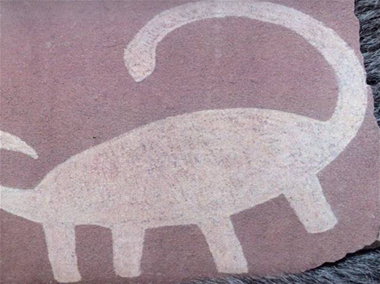
Utah's White Canyon Region
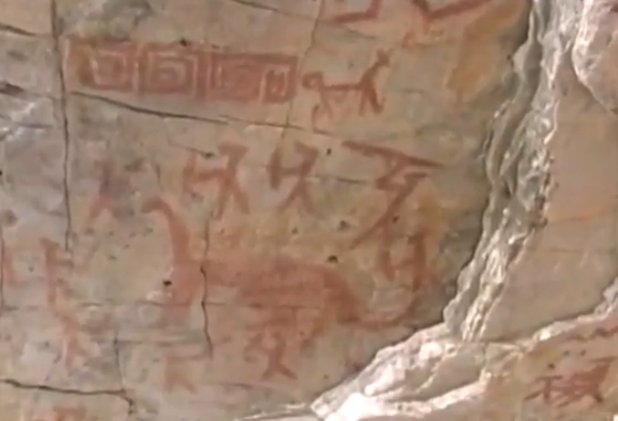
Amazon Rain Forest Basin in Northern Peru

El Toro Mountain part of the "Acambaro Figurine" collection found by Waldemar Julsrud
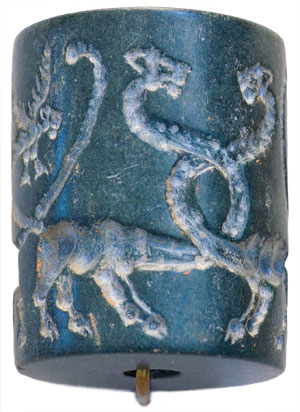
Mesopotamian Cylinder Seal of Uruk currently housed in the Louvre
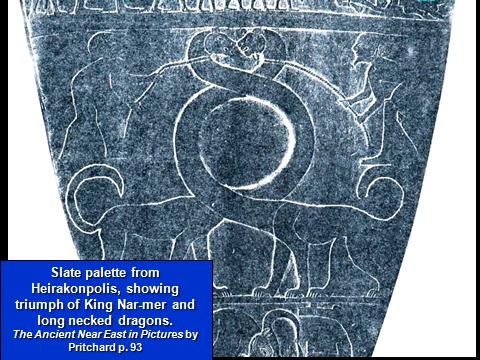
Housed at the British Museum
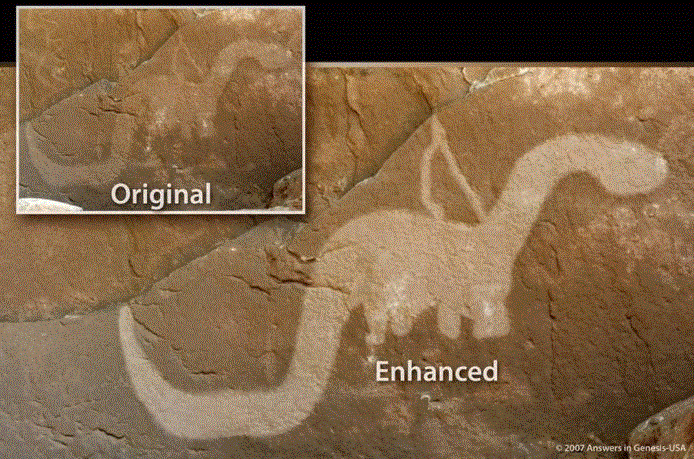
By the North American Anasazi in the area now known as Utah. A natural brownish film over top the cave drawing authenticates its age.
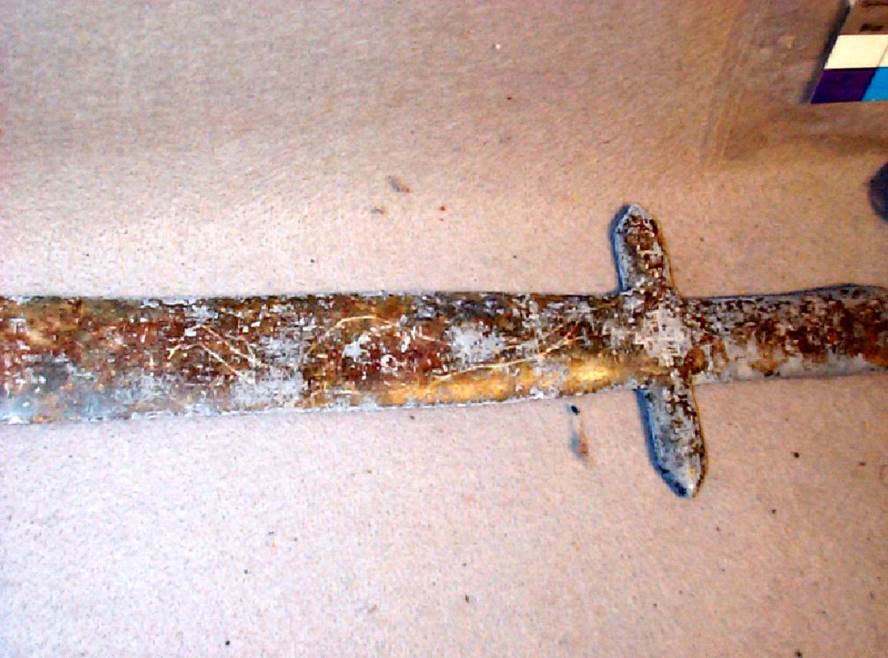
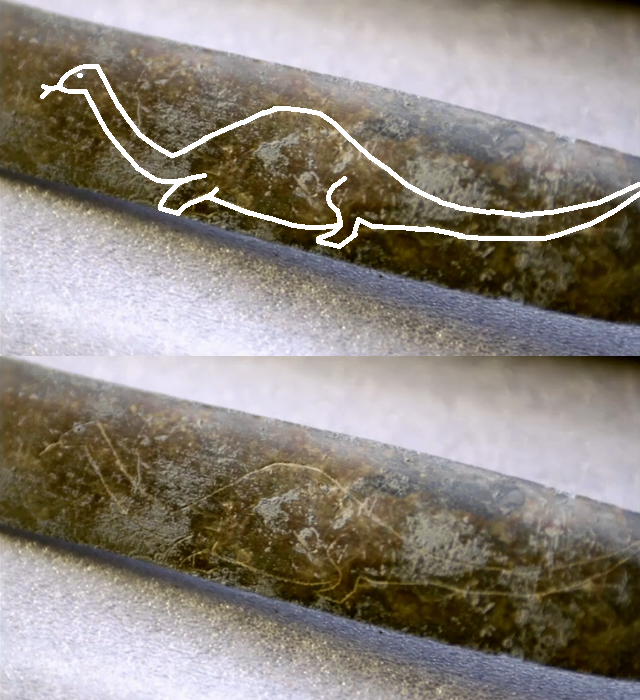
A mysterious excavation in Tucson Arizona unearthed 31 Roman-style artifacts. One of which was this sword.
Protoceratops
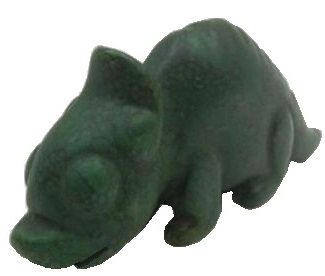
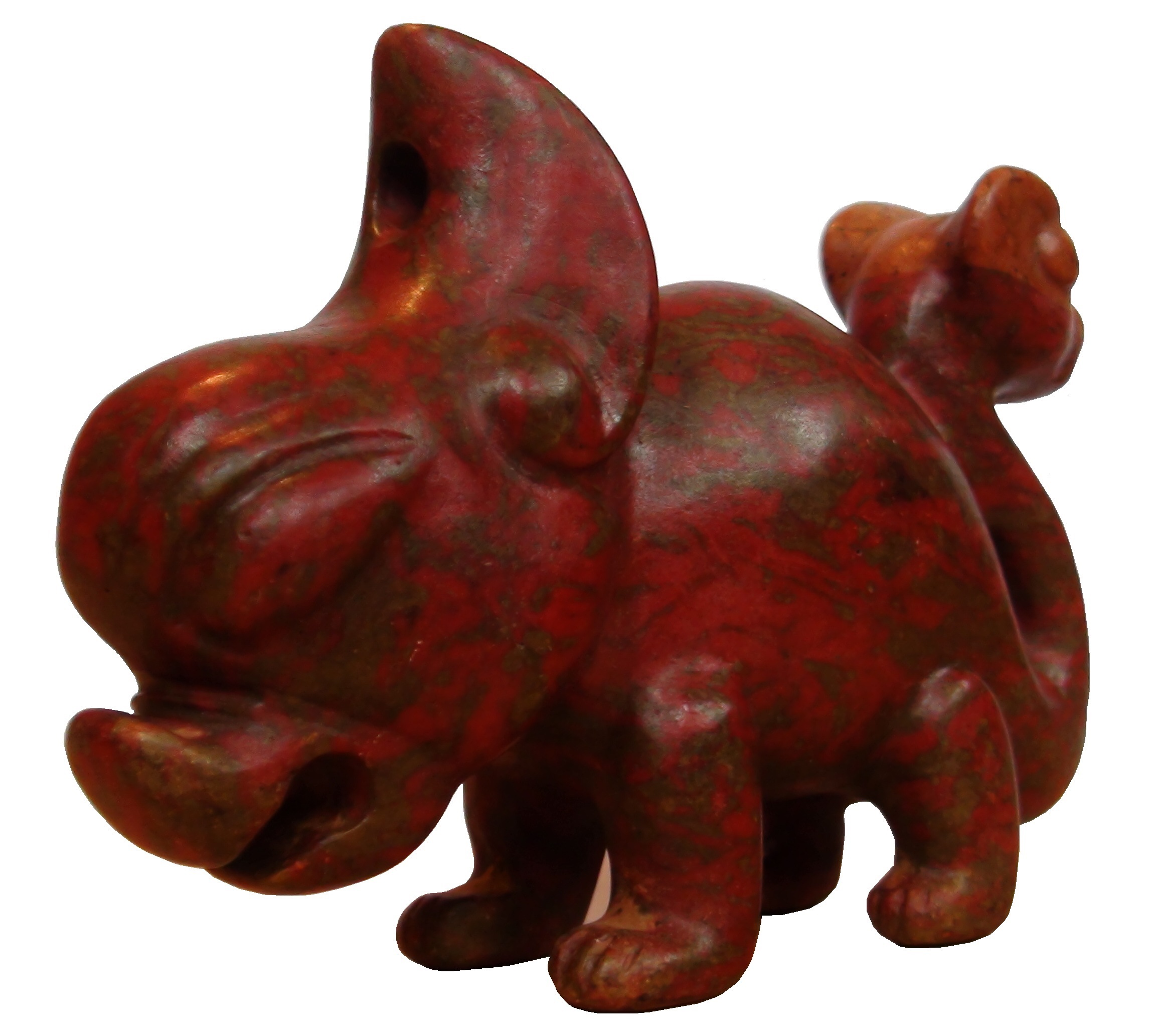
Hongshan carvings approximately 4,000 years ago China
It is also important to note that the average dinosaur was approximately the size of a full grown dog.
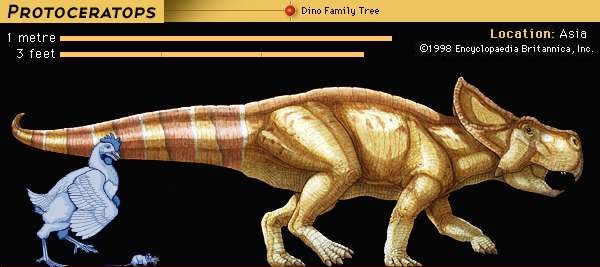
Stegasaurus
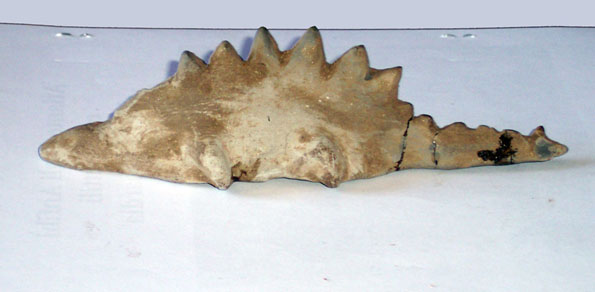
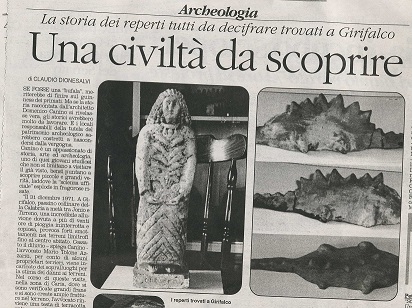
Girifalco region of Southern Italy.
Tyranosaurus Rex
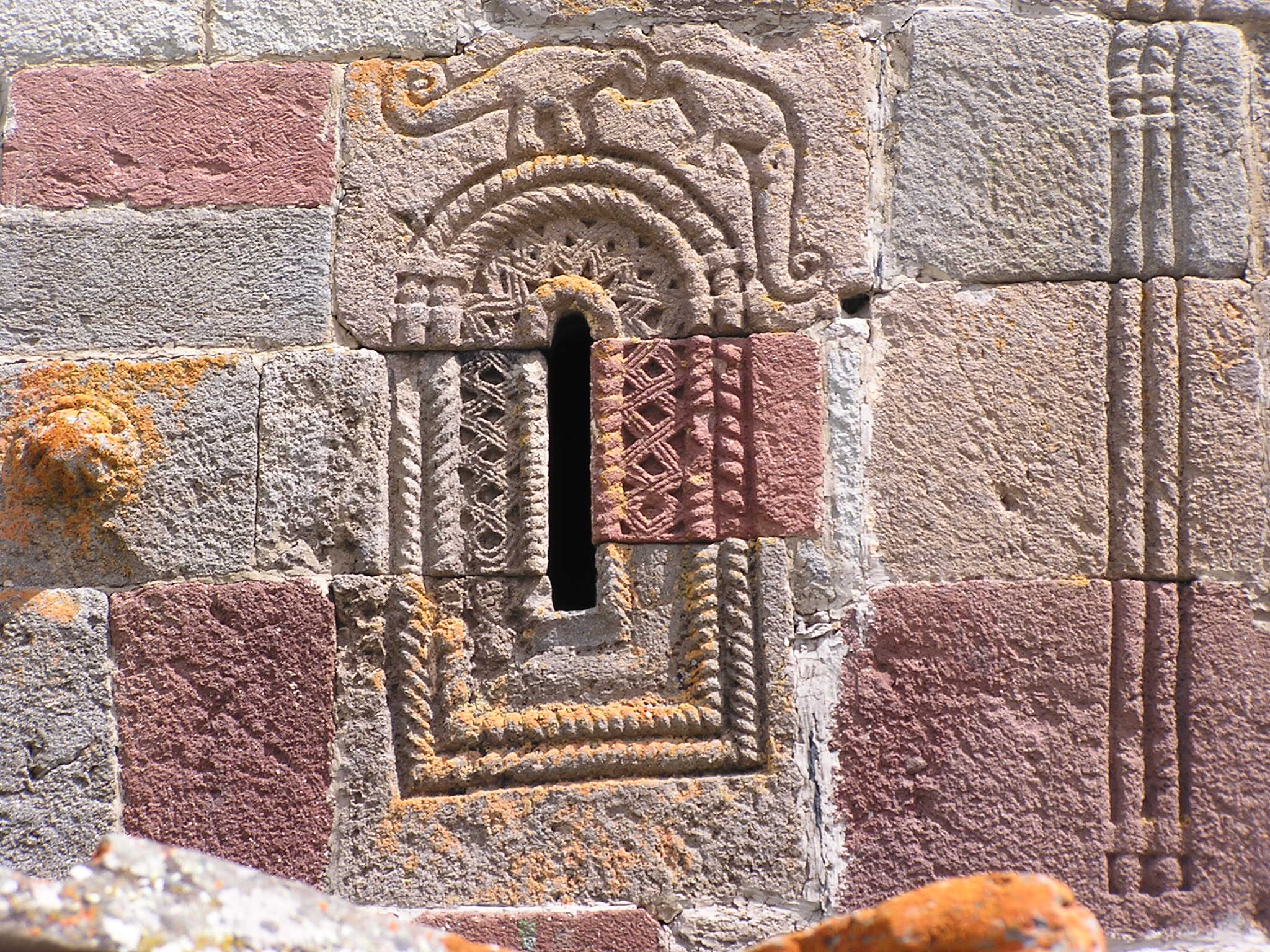
Holy Trinity Church built in the 1300s in the country of Georgia.
These dinosaurs are not limited to physical depictions. They have also been written about. Extensively. Here is a beast from Beowulf, the Anglo-Saxon Epic:
"Grendel's swift hard claws
snatched at the first Geat
He came to, ripped him apart, cut
His body to bits with powerful jaws,
Drank the blood from his veins and bolted
Him down, hands and feet; death
And Grendel's great teeth came together,
Snapping life shut."
"but their weapons
Could not hurt him,
the sharpest and hardest iron
Could not scratch at Grendel's skin"
“The fiend reached for him with his claw, but he grasped it with set purpose, and
threw his weight on Grendel’s arm.”
This creature had huge jaws that could devour people whole, was bipedal with arms, and tough skin. This quite accurately describes a tyrannosaurus rex, or more accurately the Megalosaurus which fossils have been found in the Anglo-Saxon area. In Beowulf, Grendel, which means “to Below” (like you would imagine a T-rex-like creature would), even had a mother of the same kind, insisting it was a real biological creature.
This may be shocking. But scientific observation insists on the co-existence of humans and dinosaurs. Here is a picture of some red blood cell fragments and soft tissue (indicated by the arrow) found in Tyranosaurus Rex remains:
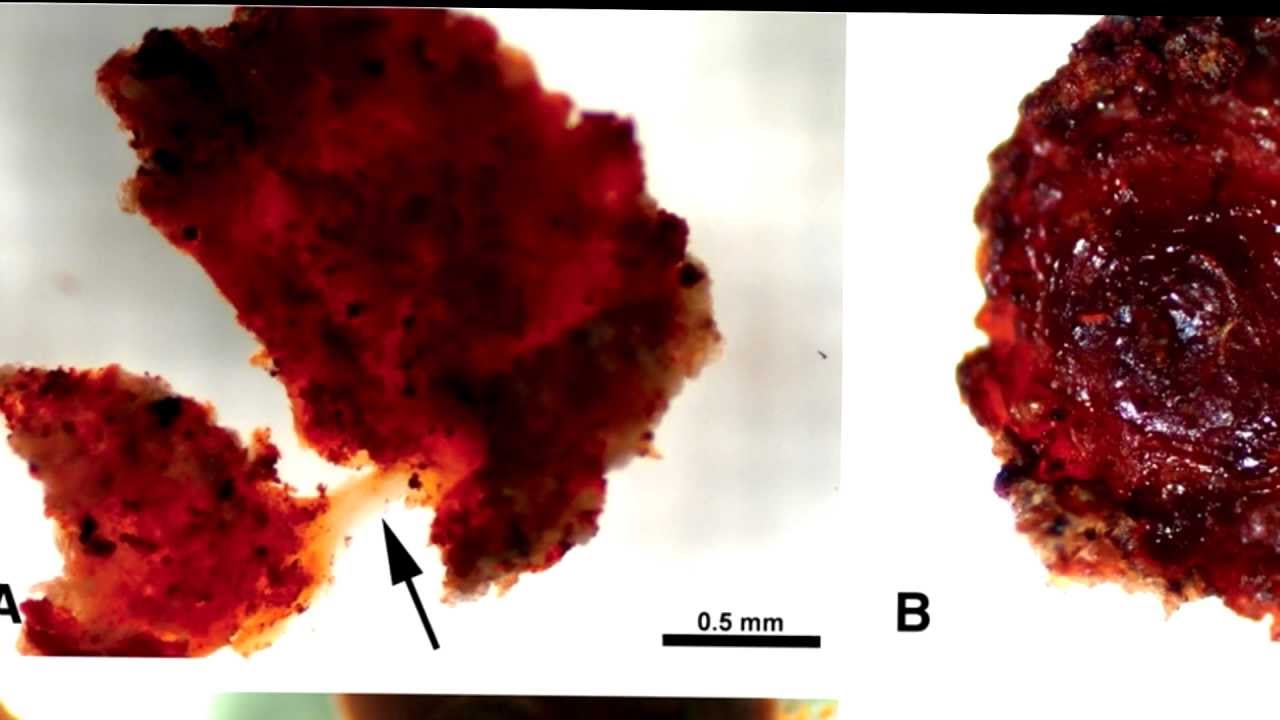
The Anglo Saxon language had many words to describe the various types of large reptilian creatures. The following is from “A Concise Anglo-Saxon Dictionary” by John R. Clark Hall:
Ûhtfloga: twilight−flier dragon
Wîdfloga: wide−flier dragon
Draca: sea−monster dragon
Eorðdraca: dragon that lives in the earth.
Lyftflog: generic flying dragon
Nîðdraca: hostile dragon
sædraca: sea−dragon.
Wyrmhord: hoard of dragons
The Brachiosaurus was also written about. The writer of the book of Job clearly describes the attributes of a brachiosaurus and calls it ‘Behemoth’ (or ‘Bahamut’ for FF7 fans), a chief of the creations of God:
Job 40:15-23
“Lo, I pray thee, Behemoth, that I made with thee: Grass as an ox he eateth.
Lo, I pray thee, his power [is] in his loins, And his strength in the muscles of his
belly.
He doth bend his tail as a cedar, The sinews of his thighs are wrapped together,
His bones [are] tubes of brass, His bones [are] as a bar of iron.
He [is] a beginning of the ways of God, His Maker bringeth nigh his sword;
For food do mountains bear for him, And all the beasts of the field play there…
Lo, a flood oppresseth -- he doth not haste, He is confident though Jordan Doth
come forth unto his mouth.”
This shows Behemoth was an Herbivore, had a tail the size of a large tree, and was very large. There is only one animal like this in the history of the world. The Brachiosaurus. As shown in the Mesopotamian cylinder seal and the Egyptian plates, the brachiosaurus was a known creature in the region where Job would have been living.
Other well known historians have depicted dinosaurs in a very matter of fact manner.
Herodotus – 5th Century B.C.
“There is a place in Arabia, situated very near the city of Buto, to which I went,
on hearing of some winged serpents; and when I arrived there, I saw bones and
spines of serpents, in such quantities as it would be impossible to describe. The
form of the serpent is like that of the water-snake; but he has wings without
feathers, and as like as possible to the wings of a bat.”
Brachiosaurus

Utah's White Canyon Region

Amazon Rain Forest Basin in Northern Peru

El Toro Mountain part of the "Acambaro Figurine" collection found by Waldemar Julsrud

Mesopotamian Cylinder Seal of Uruk currently housed in the Louvre

Housed at the British Museum

By the North American Anasazi in the area now known as Utah. A natural brownish film over top the cave drawing authenticates its age.


A mysterious excavation in Tucson Arizona unearthed 31 Roman-style artifacts. One of which was this sword.
Protoceratops


Hongshan carvings approximately 4,000 years ago China
It is also important to note that the average dinosaur was approximately the size of a full grown dog.

Stegasaurus


Girifalco region of Southern Italy.
Tyranosaurus Rex

Holy Trinity Church built in the 1300s in the country of Georgia.
These dinosaurs are not limited to physical depictions. They have also been written about. Extensively. Here is a beast from Beowulf, the Anglo-Saxon Epic:
"Grendel's swift hard claws
snatched at the first Geat
He came to, ripped him apart, cut
His body to bits with powerful jaws,
Drank the blood from his veins and bolted
Him down, hands and feet; death
And Grendel's great teeth came together,
Snapping life shut."
"but their weapons
Could not hurt him,
the sharpest and hardest iron
Could not scratch at Grendel's skin"
“The fiend reached for him with his claw, but he grasped it with set purpose, and
threw his weight on Grendel’s arm.”
This creature had huge jaws that could devour people whole, was bipedal with arms, and tough skin. This quite accurately describes a tyrannosaurus rex, or more accurately the Megalosaurus which fossils have been found in the Anglo-Saxon area. In Beowulf, Grendel, which means “to Below” (like you would imagine a T-rex-like creature would), even had a mother of the same kind, insisting it was a real biological creature.
This may be shocking. But scientific observation insists on the co-existence of humans and dinosaurs. Here is a picture of some red blood cell fragments and soft tissue (indicated by the arrow) found in Tyranosaurus Rex remains:

The Anglo Saxon language had many words to describe the various types of large reptilian creatures. The following is from “A Concise Anglo-Saxon Dictionary” by John R. Clark Hall:
Ûhtfloga: twilight−flier dragon
Wîdfloga: wide−flier dragon
Draca: sea−monster dragon
Eorðdraca: dragon that lives in the earth.
Lyftflog: generic flying dragon
Nîðdraca: hostile dragon
sædraca: sea−dragon.
Wyrmhord: hoard of dragons
The Brachiosaurus was also written about. The writer of the book of Job clearly describes the attributes of a brachiosaurus and calls it ‘Behemoth’ (or ‘Bahamut’ for FF7 fans), a chief of the creations of God:
Job 40:15-23
“Lo, I pray thee, Behemoth, that I made with thee: Grass as an ox he eateth.
Lo, I pray thee, his power [is] in his loins, And his strength in the muscles of his
belly.
He doth bend his tail as a cedar, The sinews of his thighs are wrapped together,
His bones [are] tubes of brass, His bones [are] as a bar of iron.
He [is] a beginning of the ways of God, His Maker bringeth nigh his sword;
For food do mountains bear for him, And all the beasts of the field play there…
Lo, a flood oppresseth -- he doth not haste, He is confident though Jordan Doth
come forth unto his mouth.”
This shows Behemoth was an Herbivore, had a tail the size of a large tree, and was very large. There is only one animal like this in the history of the world. The Brachiosaurus. As shown in the Mesopotamian cylinder seal and the Egyptian plates, the brachiosaurus was a known creature in the region where Job would have been living.
Other well known historians have depicted dinosaurs in a very matter of fact manner.
Herodotus – 5th Century B.C.
“There is a place in Arabia, situated very near the city of Buto, to which I went,
on hearing of some winged serpents; and when I arrived there, I saw bones and
spines of serpents, in such quantities as it would be impossible to describe. The
form of the serpent is like that of the water-snake; but he has wings without
feathers, and as like as possible to the wings of a bat.”
a reply to: BeNotAfraid
Might as well add this here.. Drachenhöhle cave. In the middle ages, people found remains of cave bears, and they thought they were dragon bones, who could blame them, huge bones and skulls with massive teeth, as big as a horse head, if one looks at some depictions from those times, there is a resemblance, lives in a cave, big teeth, domed forehead.
Might as well add this here.. Drachenhöhle cave. In the middle ages, people found remains of cave bears, and they thought they were dragon bones, who could blame them, huge bones and skulls with massive teeth, as big as a horse head, if one looks at some depictions from those times, there is a resemblance, lives in a cave, big teeth, domed forehead.
a reply to: BeNotAfraid
Since you have started down the rabbit hole of Dragons you might as well have another angle thrown in.
The video asks the question is YHWH, the god of the Israelites, a Dragon? Then it continues by showing evidence from the Hebrew bible.
It could be a WTF moment.
Since you have started down the rabbit hole of Dragons you might as well have another angle thrown in.
The video asks the question is YHWH, the god of the Israelites, a Dragon? Then it continues by showing evidence from the Hebrew bible.
It could be a WTF moment.
edit on 6-6-2023 by TheLieWeLive because: (no reason given)
a reply to: TheLieWeLive
Yeah, that Christian origins bit in the Bible being just leftovers can be a punk to deal with. I tend to post this now and then on ATS, but I've only recently made a u-turn back towards Christ. Anyway, back to the dragon.
As I learn more about what Christ and the deal with dragons, the data aggregates. You know how it is. So, to finally address your post here, at this moment, and God forgive my stupidity, but this is what I'm thinking...
Eve totally boinked the Dragon before she went to Adam, and that's why humans are even more of a confused mess today. I don't know the decision making process, but I'm still calling Eve my Greatest Grandmother, and the Hero of Eden for what she did. The caveat to theological practice is that while beasts have natural instincts, humans have the Holy Ghost, and this is where I must be, because personal interpretation is not for students with Holy God as their Master of masters, Teacher of teachers, King of kings.
Dragons, historically, could care less about even another dragon's opinion. Lol!
To Hel with dragons. And Hel really does have the prettiest face. I say that because it seems dragons like to mess with pantheons of shiny Beings so much they turn into violent sitcoms.
But that's probably the "lizard" brain talking.
Yeah, that Christian origins bit in the Bible being just leftovers can be a punk to deal with. I tend to post this now and then on ATS, but I've only recently made a u-turn back towards Christ. Anyway, back to the dragon.
As I learn more about what Christ and the deal with dragons, the data aggregates. You know how it is. So, to finally address your post here, at this moment, and God forgive my stupidity, but this is what I'm thinking...
Eve totally boinked the Dragon before she went to Adam, and that's why humans are even more of a confused mess today. I don't know the decision making process, but I'm still calling Eve my Greatest Grandmother, and the Hero of Eden for what she did. The caveat to theological practice is that while beasts have natural instincts, humans have the Holy Ghost, and this is where I must be, because personal interpretation is not for students with Holy God as their Master of masters, Teacher of teachers, King of kings.
Dragons, historically, could care less about even another dragon's opinion. Lol!
To Hel with dragons. And Hel really does have the prettiest face. I say that because it seems dragons like to mess with pantheons of shiny Beings so much they turn into violent sitcoms.
But that's probably the "lizard" brain talking.
a reply to: BeNotAfraid
For some odd reason the video is no longer showing in my last post. Did you get to see it before it went poof?
Lets try this again shall we?
Weird, I have never had a video disappear out of a post before and I know it posted because I always double check.
For some odd reason the video is no longer showing in my last post. Did you get to see it before it went poof?
Lets try this again shall we?
Weird, I have never had a video disappear out of a post before and I know it posted because I always double check.
a reply to: TheLieWeLive
Gotta say, on my side, I did not see an indication other than you mentioning a video. I just took it as "there are many videos and books and whatever out there about this subject". But, hey thank you for posting it again.
... Again. ha
Gotta say, on my side, I did not see an indication other than you mentioning a video. I just took it as "there are many videos and books and whatever out there about this subject". But, hey thank you for posting it again.
... Again. ha
Dragons live in the sea. When their remains wash ashore they often appear to be snake like. Sometimes with the remnants of a wings. Those who
hunted dragons were feared and worshiped.
(Not my theory, but I think it has legs - unlike dragons!)
(Not my theory, but I think it has legs - unlike dragons!)
a reply to: BeNotAfraid
No problem, even if you disagree with the video you might find Mr. Mythos other videos intriguing, at least I do. He has a smooth and in depth presentation of his subjects. Many are fun to ponder.
No problem, even if you disagree with the video you might find Mr. Mythos other videos intriguing, at least I do. He has a smooth and in depth presentation of his subjects. Many are fun to ponder.
a reply to: TheLieWeLive
No, shoot. Lol. I've been subscribed to Mr Mythos for awhile now. His data on angels and demons and everything else is phenomenally presented. Fun stuff.
No, shoot. Lol. I've been subscribed to Mr Mythos for awhile now. His data on angels and demons and everything else is phenomenally presented. Fun stuff.
a reply to: BeNotAfraid
To me it seems obvious dragon myths exist globally because dinosaur bones were found everywhere and it was obvious to archaic people those were bones of gigantic lizards.
Which is what both dragons and dinosaurs are. Just that over time the dragon myth seperated itself from the mythgiver ie the bones. Until we had to 'reinvent' dragons as dinosaurs.
To me it seems obvious dragon myths exist globally because dinosaur bones were found everywhere and it was obvious to archaic people those were bones of gigantic lizards.
Which is what both dragons and dinosaurs are. Just that over time the dragon myth seperated itself from the mythgiver ie the bones. Until we had to 'reinvent' dragons as dinosaurs.
new topics
-
Little Johnny and Larry should team up
General Chit Chat: 5 hours ago -
Will Us use alien technology to fight in ww3?
World War Three: 5 hours ago -
posted in wrong forum
Aliens and UFOs: 6 hours ago
top topics
-
Elon Says It’s ‘Likely’ He Buys Tanking MSNBC
Political Ideology: 14 hours ago, 16 flags -
Jaguar Rebrand Video Causes "WTF?" Moment - Seriously Weird
Automotive Discussion: 17 hours ago, 15 flags -
Montelukast affects brain, caused 5 year old to attempt suicide
Medical Issues & Conspiracies: 15 hours ago, 15 flags -
Shane Gillis commercial
Jokes, Puns, & Pranks: 12 hours ago, 4 flags -
Little Johnny and Larry should team up
General Chit Chat: 5 hours ago, 4 flags -
posted in wrong forum
Aliens and UFOs: 6 hours ago, 0 flags -
Will Us use alien technology to fight in ww3?
World War Three: 5 hours ago, 0 flags
active topics
-
Elon Says It’s ‘Likely’ He Buys Tanking MSNBC
Political Ideology • 74 • : andy06shake -
Montelukast affects brain, caused 5 year old to attempt suicide
Medical Issues & Conspiracies • 10 • : DeadlyStaringFrog -
Jaguar Rebrand Video Causes "WTF?" Moment - Seriously Weird
Automotive Discussion • 21 • : Athetos -
Well we know Putins ICBMs won't fail in their silos
World War Three • 176 • : andy06shake -
Will Us use alien technology to fight in ww3?
World War Three • 3 • : Athetos -
Biden's "Reckless" Decision To Escalate Russia-Ukraine War
World War Three • 122 • : PrivateAngel -
Well, here we go red lines crossed Biden gives the go ahead to use long range missiles
World War Three • 329 • : Imhere -
International Criminal Court Issues Arrest Warrant For Netanyahu
Mainstream News • 44 • : JJproductions -
Why isn't Psychiatry involved?
Social Issues and Civil Unrest • 12 • : tamusan -
What Joe Rogan said Vs The View
Dissecting Disinformation • 22 • : TheMisguidedAngel
7
